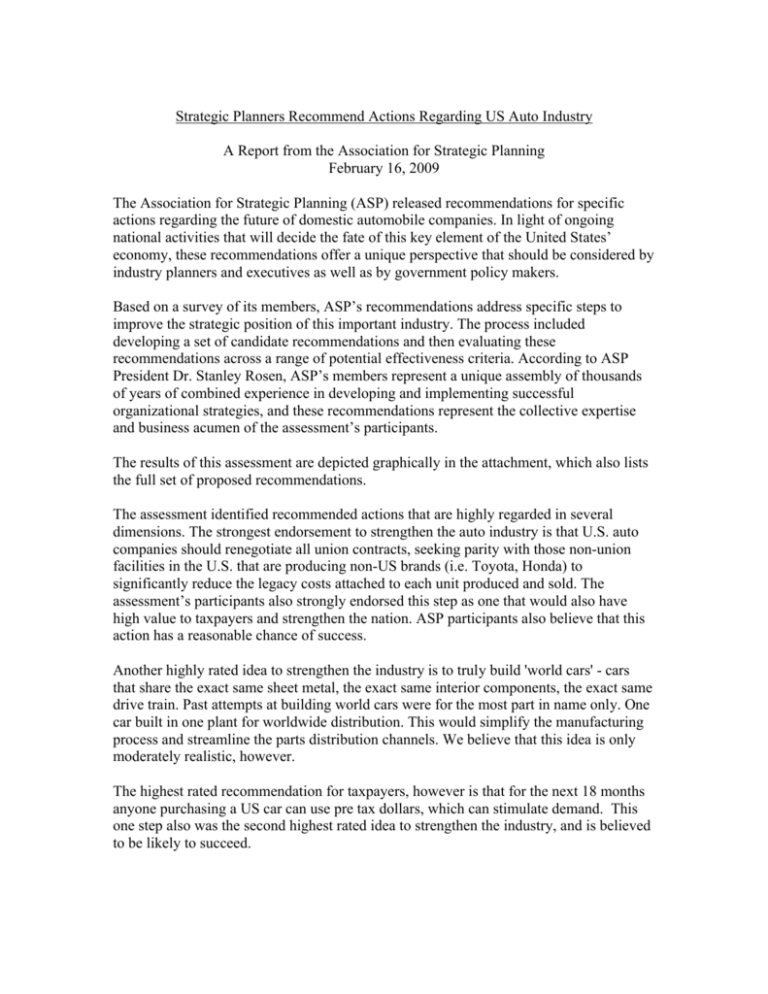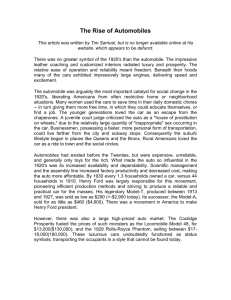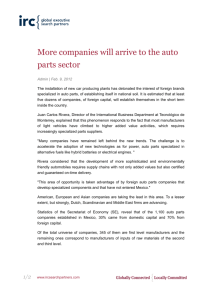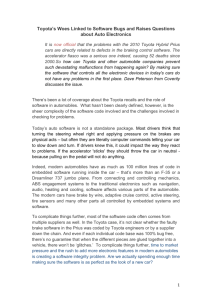Strategic Planners Recommend Actions Regarding US Auto Industry
advertisement

Strategic Planners Recommend Actions Regarding US Auto Industry A Report from the Association for Strategic Planning February 16, 2009 The Association for Strategic Planning (ASP) released recommendations for specific actions regarding the future of domestic automobile companies. In light of ongoing national activities that will decide the fate of this key element of the United States’ economy, these recommendations offer a unique perspective that should be considered by industry planners and executives as well as by government policy makers. Based on a survey of its members, ASP’s recommendations address specific steps to improve the strategic position of this important industry. The process included developing a set of candidate recommendations and then evaluating these recommendations across a range of potential effectiveness criteria. According to ASP President Dr. Stanley Rosen, ASP’s members represent a unique assembly of thousands of years of combined experience in developing and implementing successful organizational strategies, and these recommendations represent the collective expertise and business acumen of the assessment’s participants. The results of this assessment are depicted graphically in the attachment, which also lists the full set of proposed recommendations. The assessment identified recommended actions that are highly regarded in several dimensions. The strongest endorsement to strengthen the auto industry is that U.S. auto companies should renegotiate all union contracts, seeking parity with those non-union facilities in the U.S. that are producing non-US brands (i.e. Toyota, Honda) to significantly reduce the legacy costs attached to each unit produced and sold. The assessment’s participants also strongly endorsed this step as one that would also have high value to taxpayers and strengthen the nation. ASP participants also believe that this action has a reasonable chance of success. Another highly rated idea to strengthen the industry is to truly build 'world cars' - cars that share the exact same sheet metal, the exact same interior components, the exact same drive train. Past attempts at building world cars were for the most part in name only. One car built in one plant for worldwide distribution. This would simplify the manufacturing process and streamline the parts distribution channels. We believe that this idea is only moderately realistic, however. The highest rated recommendation for taxpayers, however is that for the next 18 months anyone purchasing a US car can use pre tax dollars, which can stimulate demand. This one step also was the second highest rated idea to strengthen the industry, and is believed to be likely to succeed. From the standpoint of actions that will specifically strengthen the nation, the second strongest recommendation is to continue to develop smart technology to evolve to more efficient gas and other energy sources (since we will continue to have/need gas fueled vehicles for at least the next 2 decades), and begin marketing to the consumer why they should buy something other than large, inefficient SUVs and over priced luxury vehicles. The Association is continuing to identify and evaluate critical steps this industry can take, including the role of management culture, product styling and quality, and additional definition of union agreements and relationships. The complete results of the assessment are available for review, and will be presented at ASP’s annual conference, to be held in San Diego February 22-24, 2009. The Association for Strategic Planning is the only not-for-profit professional association dedicated to advancing thought and practice in strategy development and deployment for business, non-profit and government organizations. ASP provides opportunities to explore cutting-edge strategic planning principles and practices that enhance organizational success and advance members' and organizations' knowledge, capability, capacity for innovation, and professionalism. Scales: X Axis Y Axis Size Color = = = = Value to Auto Industry (Will this strengthen the industry?) Value to Taxpayers (Will this strengthen the country?) Realism (How likely is this to work?) Specificity (Is it clear what is to be done?) Issues: 1. Establish alternative unions to represent the labor force, and let them compete for members and for work. The best offer would be selected by the employers, and the union winning the work would be in the best position to attract members. 2. Ask government to stop overregulating the industry. For example, overly rigorous CAFE standards may not be economically achievable. 3. Truly build 'world cars', cars that share the exact same sheet metal, the exact same interior components, the exact same drive train. Past attempts at building world cars were for the most part in name only. One car built in one plant for worldwide distribution. This would simplify the manufacturing process and streamline the parts distribution channels. 4. Renegotiate all union contracts, seeking parity with those non-union facilities in the US that are producing non-US brands (i.e. Toyota, Honda) to significantly reduce the legacy costs attached to each unit produced / sold, 5. Disband the unions and find a way to support the victims who lose their pensions 6. Support the Pickens plan to make new 18 wheelers powered by natural gas. Natural gas is much cleaner, much cheaper and the U.S. is the Saudi Arabia of natural gas. This move will also go a long way towards making the U.S. energy independent. 7. Address the question: What is the future of transportation in the US? The US auto companies should refocus on transportation, not cars and trucks. This involves imagining what the future of transportation is going to be (high-speed rail, public transportation that runs on natural gas or electricity, etc.) and then designing products for that world (US and other countries). 8. Significantly reduce the size of the automobile. Studies of the use of automobiles and the effects of their size on the people-carrying capacity of streets and highways have revealed that a two-person vehicle in which the passenger sat behind the driver would increase the capacity by about 500 percent. . . . such a vehicle would alleviate the demand for fuel and reduce air pollution, both of which were correctly anticipated as constraints on the industry. 9. Start making transit buses in the U.S. 10. The auto industry needs to cull down the number of models/choices offered. GM should eliminate all of their brands except for Chevy & Cadillac. That would allow them to focus and prune dealerships at the same time. 11. Continue to develop smart technology to evolve to more efficient gas and other energy sources (we will continue to have/need gas fueled vehicles for at least the next 2 decades), and begin marketing to the consumer why they should buy something other than large, inefficient SUVs and over priced luxury vehicles. 12. Streamline the entire supply chain. 13. Create a unique car and a new brand for the masses, the people in this country. Call it something like the 'Americans peoples' car' similar to the Volkswagen Beetle. Market the idea the idea that this car will help people who are on a tight budget, or even victims of the economic downturn or they are just smart and ahead of others, because they prefer to live more economically 14. 15. 16. 17. 18. 19. 20. and support green. Furthermore, market the idea that this car will support the recovery of the US automotive industry. Most importantly: Make it the cheapest car ever made and sold in the US! Follow the rationale of Tata, however, make it a bit hip or attractive. Create a combination of a cheap Tata car with the features of the SMART and the Mini. Pay especially attention to safety, and make it not only fuel-efficient, but even a hybrid. Additionally, add a technically cool and useful feature to it, for example a build-in iPod / hands-free phone set / a simple navigation system or something that has not been on the market, yet. Build this car in a collaborative project with all 3 US automakers, using synergies, reducing costs for the development, reducing time-tomarket etc. Focus on green in all aspects of the business model, organization and product line. Use this commitment to "all things green" to differentiate the industry. Take a strong unflinching stand. Instead of focusing on short term returns look to be a leader in pointing the way towards a sustainable planet. Get out and educate everyone of the long term impact of this strategy. Scrap those models not producing significant unit sales, and make it job #1 to produce the most energy efficient and environmentally friendly cars and trucks produced, anywhere. Expand use of vehicles powered by compressed natural gas or the adoption of hydrogen fuel cell technology. Both sources of power are cheap and abundant. Compress natural gas, in particular, is a viable option because the nation already has the infrastructure to deliver the energy source. In every large metropolitan area and most rural towns exists extensive networks of gas mains and vertebrae. T. Boone Pickens is right. Natural gas is clean, abundant and easily accessible and distributable in the US. Mobilize to beat Toyota and Honda to the plug-in hybrid. The future lies with renewables-generated electricity. Dedicate the resources to develop and commercialize the (already existing!) technology FAST, then transition the vast majority of existing models to plug-in hybrids. Leading will ultimately create competitiveness, though obviously, this will not happen overnight. Historical data should be used to cut production back to where it was when the demand was the same as it is today. Five years ago the industry was selling the same quantity of cars it is selling today and making a profit and the country viewed the economy as healthy. The consumer is cutting back and industries must do the same and the market will correct itself. The problem with the auto industry "rescue" package is that is doesn't address the problem low demand, which is consumers are not buying. For the next 18 months anyone purchasing a US car can use pre tax dollars. Guarantee privately offered vehicle warranty insurance. Offer cash to the public to buy older, polluting vehicles thereby stimulating demand in exchange for manufacturers accepting lower vehicle CO2 emissions targets. 21. If customers are having trouble borrowing money to purchase autos, the manufacturers should leverage their lending business to provide credit to buyers. Captive finance companies require innovative products and credit policies to account for consumers who have successfully rehabilitated their financial situation, but whose credit record still remains scarred from the mortgage loan debacle. Credit policies that can account for the 'assignable cause' of the variant credit rating while employing comprehensive debt service analysis can assist US auto makers in stimulating real demand for their vehicles. 22. Establish profit sharing with the government and individual investors in the most efficient product initiatives. 23. Government funds should be made available to facilitate industry transition (in return for equity), and should be offered to all qualified companies (including e.g. Tesla). Companies demonstrating best market acceptance and profitability would receive follow-on tranches. The Government would eventually sell its shares on the market. 24. Leverage and partner with education reform initiatives to provide transferable skills training to displaced auto workers; help them find new jobs and careers. Give them financial help to buy some time to adjust their lives to a new economic level. Help with refinancing mortgages. Work with the vendors and industries who will be impacted to retool their purpose and find new customers. 25. Ask government to stop overregulating the industry. For example, overly rigorous CAFE standards may not be economically achievable. 26. Perhaps the place to start is to ask a few questions: 1)what is the primary objective? To preserve jobs in the US? To preserve US ownership of manufacturers? To make sure we don't abandon owners of cars already purchased? To bail out incompetent managers? 2) If the companies were to disappear, what in the fallout and how can that be minimized to employees, retirees, past customers? 3)What is the appropriate level of support to those who are "victims" in this crisis, and all the others (housing, investment fund loses, etc.). 27. The three major auto companies (Ford, GM, and Chrysler) should be merged into one company to be called "US Auto." Eliminate duplicate manufacturing facilities and executive jobs. Utilize as many standard components as possible to greatly reduce repair costs. 28. Let the industry die a dignified death and focus on emerging industries where the USA clearly has competitive advantages. We were great once and we won't be again. And, yes, this change means dealing with some sacred cows, including political self-interest and education system reform. 29. Form new public companies that can manufacture innovative vehicles (perhaps for current companies' designers) using modern methods and processes (including management and labor processes), and 30. 31. 32. 33. transfer the workforce to these new entities. Start over with systems thinking people and theory y leadership team and build it from the ground up. If you can't figure out what to do, look at Toyota. Their performance measures are stunning. It's time to finally learn what a Lean Culture really is (hint, it's not just about the processes). Implement a pre-packaged bankruptcy with the government providing extended unemployment benefits and covering healthcare costs for laid off workers. A fire sale to the foreign manufacturers already manufacturing cars in the US is probably the most efficient and logical step of all. Use the power of the auto industry to get behind a sensible national health insurance program. The government should support a transition (esp of the blameless workers) to alternative energy sources and means of transportation, both growing sectors. Co-create cars models with customers. Or develop innovative ways to let auto buyers configure the vehicles they purchase, working with experts at the dealerships or online. Use the computer to decimate the time to manufacture and deliver.







